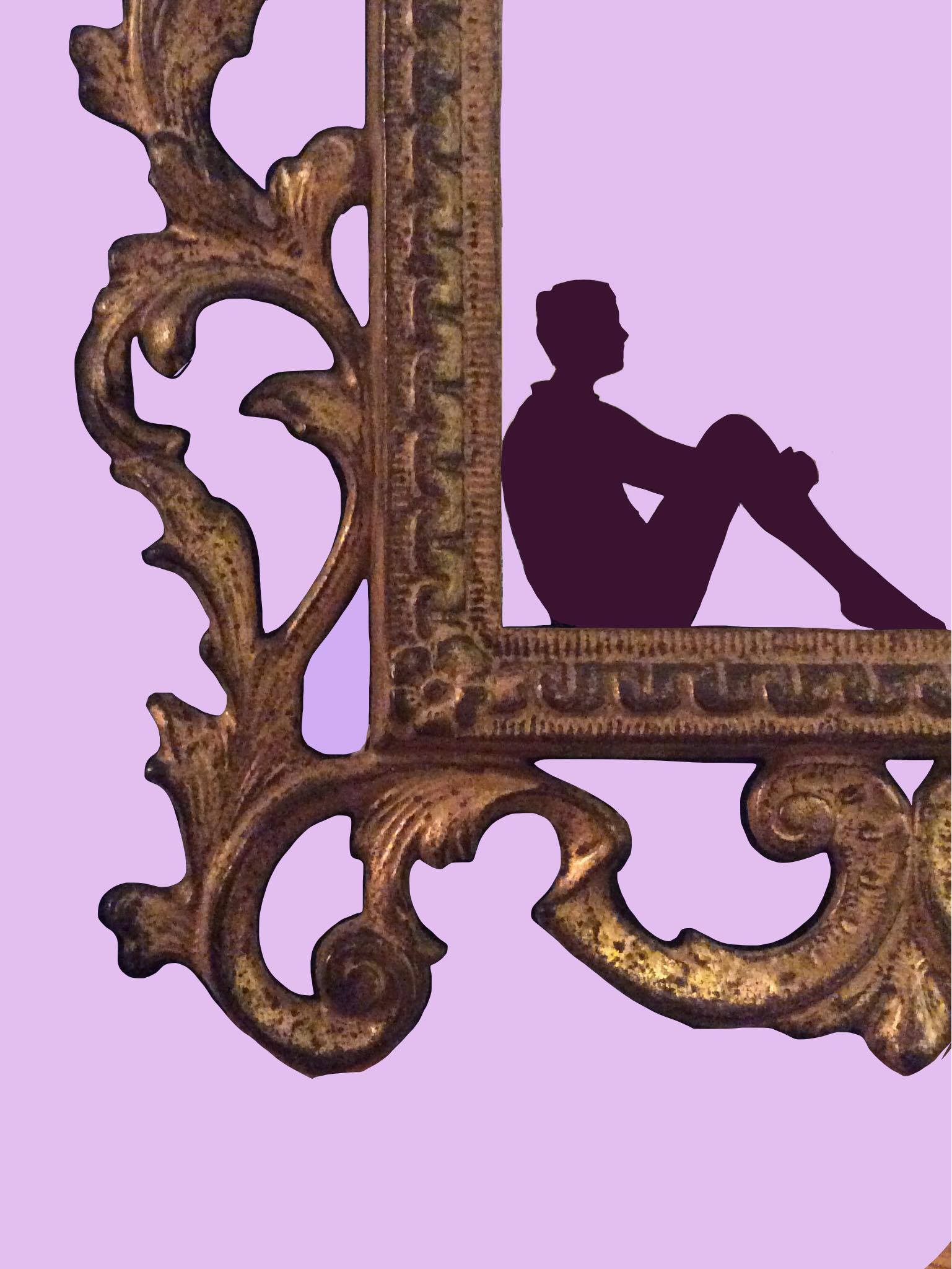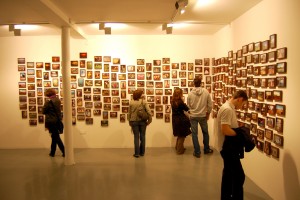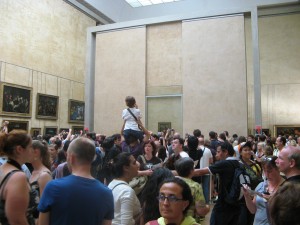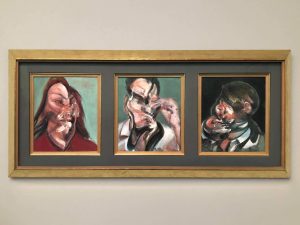
Why do gallery visitors have no bodies?
by Surya Bowyer | October 11, 2017
Picture this. Someone dashes past you in a gallery, camera in hand, voraciously taking photographs of the famous works, passing swiftly by the others without paying them so much as a second look. How ubiquitous this occurrence has become. The focus on certain artworks — the famous ones — is not entirely illogical; after all, uploading a photograph of the Mona Lisa will generate more double-taps from the crowd of followers on Instagram than a photograph of Jan Gossaert’s self-portrait, however more interesting Gossaert’s painting may be.
But why photograph works at all? With the advent of photography has come a shift in the status of the artwork image. To see the Mona Lisa one once had to travel to Paris. Nowadays it can hardly be avoided: it is plastered on mugs, phone cases, t-shirts, tote bags, pencil cases, watches, water bottles, bed sheets, flip flops. If this barrage of reproductions has somehow been avoided, a quick Google search will yield a high-quality image of it. In John Berger’s words, the art work image has become ‘ephemeral, ubiquitous, insubstantial, available, valueless’.[i]
This seeming removal of power, from the artwork image by photography, paradoxically drives gallery visitors’ desire to photograph the original works. For the resultant photographs are not merely reproductions — they belong not on flip flops — but rather documents providing evidence. When you upload your photograph of the Mona Lisa on to Instagram you are bellowing Look, I have seen the original object from which all of these reproductions are based. I have been to ground zero. I have hunted the river to its source.
Using an image to bellow is a key symptom of our age, defined as it is by a rapid shift in communication culture from the verbal to the visual. The question “How was your day” is no longer answered with “It was fine” or “It was awful”, but with a photograph on Instagram. Those who have been most fully affected by this shift — millennials, generation Y, whichever vapid label you prefer — are, we are told by numerous headlines, having less sex than their lascivious boomer predecessors.[ii] And we are told a key reason for this is technology: screens to look at have replaced bodies to fornicate with. Even when we do have sex, pillow talk and a cigarette has been usurped by the customary post-coital Instagram scroll. A study by the Royal Society for Public Health and the Young Health Movement into social media platforms found Instagram and Snapchat to have the joint strongest negative effect on young people’s mental health. The platform with the strongest positive effect was identified as YouTube.[iii] Positive or negative, images have a more powerful effect on us than other forms of media.
Yet if this cultural shift has placed an increasing emphasis on the act of looking and on the value of images, the ubiquity of the personal camera within galleries is also encouraged by the space itself. Brian O’Doherty argues that the modern white cube gallery space welcomes eyes and minds, but not space-occupying bodies. The space focusses solely on our vision at the expense of other senses: in O’Doherty’s words ‘your own body, seems superfluous, an intrusion’.[iv] Thus the camera, as a seemingly natural yet also contrivable extension to the eye, appears at home in the gallery. The space itself calls for its use.
The issue that arises here is whether the camera aids or hinders one’s experience of the gallery. Conventional wisdom would argue the former: that the democratisation of photography away from a trained and privileged minority can only bring benefits. Everyone can now record their memories with ease — point, and shoot. But the idea that the camera records memories is a conflation: the camera records images associated with memories, not memories themselves. The wash of nostalgia — the momentary transportation to an earlier time — that you experience when smelling an old cologne not worn in years cannot, for instance, be achieved by the camera.
Drawing clear this distinction may seem pedantic; for, surely the point remains that the camera is able to aid visual memory. But even this is not the case. Linda A. Henkel carried out two experiments in 2013 which examined the effect taking photographs during a museum tour had on participants’ memory. The conclusion reached was that photographing objects rather than just looking at them makes us forget them more easily: the very act of photographing something makes people dismiss it from their memory.[v] The photograph usurps the memory. When walking around a gallery we must ask ourselves which is more valuable, image or experience itself?
We may be forgiven for preferring the image. The white cube’s focus on providing a blank canvas upon which the work is hung has meant that the gallery experience is focused on looking. It is not so much a multi-sensorial experience as a series of moments spent looking at works. O’Doherty has noted the eternity of display within the modern gallery space: our understanding of time is removed or limited. Windows are located in the roof, providing a glow of light rather than any nuanced sense of the time of day; walls and rooms are generally all the same white cube. O’Doherty goes on to affirm ‘one has to have died already to be’ in the gallery space, that ‘Presence before a work of art’ requires us to ‘absent ourselves in favour of the Eye and the Spectator’.
This ties into a larger argument O’Doherty makes about modern existence: that most of our experiences are now mediated, dealt with in ‘proxies and surrogates’, no longer direct. Whenever we enter a gallery, argues O’Doherty, ‘we are really holding a mini-seminar with our surrogates’ — the Eye and Spectator — ‘who report to us what we might have seen had we been there.’[vi] If this seems an excessively deconstructivist view of identity and the self, it probably is. But O’Doherty nonetheless raises an important point: that when we visit galleries, we focus entirely on what we see. Being present in a gallery means absenting everything but our eye and, in particular, absenting our bodies.
O’Doherty’s idea that ‘one has to have died already’ to be in a gallery is not an idle analogy; his ideas about the gallery experience tie into the modern phenomenological understanding of death. Heidegger has spoken of death as ‘the shrine of Nothing, that is, of that which in every respect is never something that merely exists, but which nevertheless presences’.[vii] To die is to no longer exist in the present, yet it is this very absence which is presenced for those still living. When we look at an artwork in a gallery we also presence an absence, one of our own physicality: an absence of all but the eye.
When speaking of the death of his friend Paul de Man, Jacques Derrida notes that death makes us speak of rather than with.[viii] Speaking of is a disconnected act — it is based on previous memories, and is necessarily one-way. Discourse becomes monologue. Interaction ceases. This too ties in to the modern gallery experience. Walter Benjamin’s idea that the aura of the original artwork withers in the age of mechanical reproduction has not occurred.[ix] For, whilst the artwork image is now reproducible, the object itself is not. As such, galleries which exhibit already-famous artworks now think of themselves as museums: the focus is on the rarity of the artwork-object rather than the experience the artwork provides. Although illuminated by LEDs, the Mona Lisa sits behind bulletproof glass which is prone to glare. Visiting it is no longer about experiencing the artwork: rather than interacting with the work, we are content merely being in the presence of a rare object. Personal photos taken of it in the Salle des Etats have no visual value — they are exclusively pieces of evidence documenting one’s pilgrimage.
Pilgrimage is the correct word here, for these rare objects, once artworks, are now treated like shrines. Berger directly links this ‘bogus religiosity’ to the rise of cameras making all artworks reproducible. The focus of a gallery visit falls simply on being in the presence of a rare object, in Berger’s words a ‘holy relic’.[x] As a result of this, the need for thoughtful use of exhibition space is largely removed. Yes, we must be able to see the work (though the Mona Lisa proves that even this rule can be bent), but there is usually little thought given to the interplay between visitor, gallery space, and work. Rather than being exhibited, artworks are merely hung. A gallery visit becomes an opportunity to pay deference to a rare object: the gallery experience is one of the artwork object, rather than one with it.
The modern gallery space thus serves only those who find the objects within it of enough interest to warrant a visit. In doing so, galleries ignore their own physicality as buildings. The white cube epitomises this attitude. All white cubes attempt to look the same, and thus attempt to create a space where visitors can ignore the very fact that they are in a space. Distinctness and nuance are both removed, with the ultimate aim a gallery space that is invisible — or at least so familiar that it is hardly noticed. But what then is the point of the gallery building at all? One can view most artworks online, so why the need to house them in a building? The only justification which remains is that galleries provide the public with the opportunity to be in the presence of the original object. The familiarity, or invisibility, of the gallery space allows for this experience of the original object to be as unmediated as possible — allows Instagram-bound photographs to be as de-cluttered as possible. This is not a satisfactory justification. Galleries should not simply forget they are buildings.
The 9th Berlin Biennale had issues. For one, a facile sarcasm infested much of the show. But it also had its triumphs. The colossal centrepiece, Cecile B Evans’s video work What the Heart Wants, was not simply shown on a screen in a plain room. The hangar-like space was flooded with water, with smaller screens floating like buoys around a central walkway which lead up to the main screen. Visitors could teeter on the edge of the walkway, staring into the water beyond, intensely aware of both the gallery space and their own bodies — or rather, intensely aware of how the two interacted. Rather than treating visitors as merely sets of eyes and minds, the space demanded visitors’ bodies. No one absent-mindedly whistled around the space, camera in hand. This is the opposite of a white cube: it is a gallery space that is aware of its space — that uses its space — rather than trying to make it indiscernible.
Biennales have become the breeding ground for installation art of this type, but there is hope for the gallery elsewhere. Tate Modern’s new extension Switch House, perhaps as a result of being devoid of any real showpiece work, often demands visitors’ bodies interact with the space. In one room, stepping into a spotlight triggers a multimedia work’s performance on the wall in front of you. In another, Apichatpong Weerasethakul’s video installation “Primitive” forces us to decide in which order to approach the numerous screens. And down behind The Tanks in the basement lies a pitch-black space, seemingly forgotten by curators. The enveloping darkness forces you to stumble forward, grasping for any sense of what lies ahead, intensely aware that you may trip or bang your head — intensely aware of your own body. Then, suddenly, your body triggers a sensor and the light-based artwork switches on.
This attention to the space of the gallery comes more naturally to installation art, yet it need not be limited to it. When the Royal Academy announced an exhibition on abstract expressionism was to grace its walls in late 2016, one may have expected a run-of-the-mill white cube-esque affair. After all, this was to be first major group show of abstract expressionist art since 1959, so the mere scale of the selection of works would have been enough to sell the show to the public. And, by and large, the exhibition was indeed a prosaic, white cube-esque affair. But not entirely. The selection of Rothkos were hung in the Wohl Central Hall.
The Hall is the heart of the main galleries, lying in the very middle. It is octagonal in shape, whereas the other rooms are rectangular. Often it proves something of a problematic space for curators. But for the Abstract Expressionism exhibition, the lights were dimmed and Rothko’s towering blocks of colour were hung one-by-one on all sides of the room. Upon entry, the works immediately encapsulated visitors’ bodies, the low light levels beckoning a closer approach. The room demanded visitors allow the skyscrapers of colour to tower over them. Pollock once said that abstract painting ‘confronts you’; the Stonehenge-like monument in the Central Hall provided a considered spatial context for this confrontation to take place.[xi]
The British Museum’s Hokusai exhibition provided an occasion for the Museum’s first attempt at making a documentary. In an understandable money-making scheme, the documentary was first shown in cinemas in a very limited release. A few weeks later, a cut-down, hour-long version was shown on BBC 4, opening up the documentary’s audience so that anyone with a TV could tune in. The Times’s coverage of the documentary reads: ‘Thanks to close-ups from high-definition cameras, the viewer will be able to see Hokusai’s works in greater detail’ than those who visit the exhibition.[xii] Why, then, visit at all?
If they are to remain distinct from museums and engaging to the wider public, galleries must provide experiences of artworks that can only be achieved in the gallery context. The remit of an exhibition does not stop at the artworks: curators must remember that galleries are physical buildings, and that visitors have physical bodies. Rather than white cube galleries of alienation, we need galleries of interaction.
Illustration by Niamh Simpson
[i] John Berger, Ways of Seeing (London: BBC and Penguin, 1972), p. 32.
[ii] The newspaper articles were all engendered by a study carried out over twenty-five years and published in 2016: Jean M. Twenge, Ryne A. Sherman, and Brooke E. Wells, “Declines in Sexual Frequency among American Adults, 1989-2014”, Archives of Sexual Behavior 45.7 (October 2016), pp. 1713-1730.
[iii] Royal Society for Public Health, “#StatusOfMind: Social media and young people’s mental health and wellbeing” (London, 2017); available at: <https://www.rsph.org.uk/about-us/news/instagram-ranked-worst-for-young-people-s-mental-health.html>.
[iv] Brian O’Doherty, Inside the White Cube: The Ideology of the Gallery Space (Santa Monica and San Francisco: Lapis Press, 1986), p. 15.
[v] Linda A. Henkel, “Point-and-Shoot Memories: The Influence of Taking Photos on Memory for a Museum Tour”, Psychological Science 25.2 (2014), pp. 396-402.
[vi] O’Doherty, 55.
[vii] Martin Heidegger, Poetry, Language, Thought, trans. Albert Hofstadter (New York: Perennial, 2001), p. 176.
[viii] Jacques Derrida, The Work of Mourning, ed. by Pascale-Anne Brault and Michael Naas (Chicago and London: University of Chicago Press, 2001), p. 72.
[ix] Walter Benjamin, “The Work of Art in the Age of Its Technological Reproducibility”, in Selected Writings: Volume 3, 1935-1938, trans. by Edmund Jephcott, Howard Eiland, and Others, ed. by Howard Eiland and Michael W. Jennings (Cambridge, MA and London: Belknapp Press, 2002), pp. 101-133 (p. 104).
[x] Berger, 21.
[xi] Pollock is quoted on the Royal Academy’s webpage for the exhibition: <https://www.royalacademy.org.uk/exhibition/abstract-expressionism>.
[xii] Richard Brooks, “Biteback, June 4”, The Sunday Times, 4 June 2017; available at: <https://www.thetimes.co.uk/magazine/culture/biteback-june-4-p87wgjghs>.




